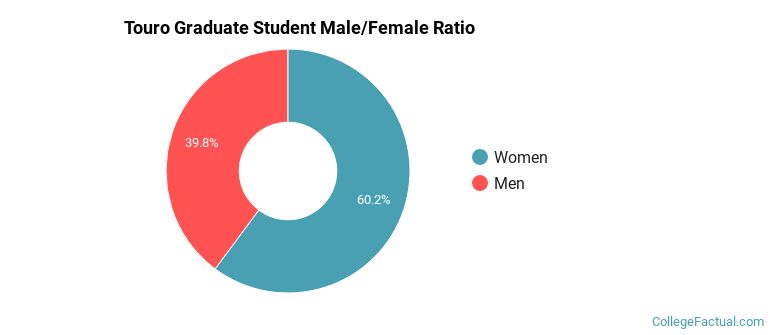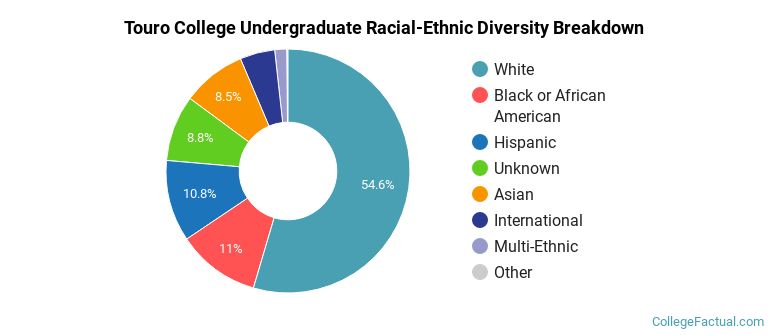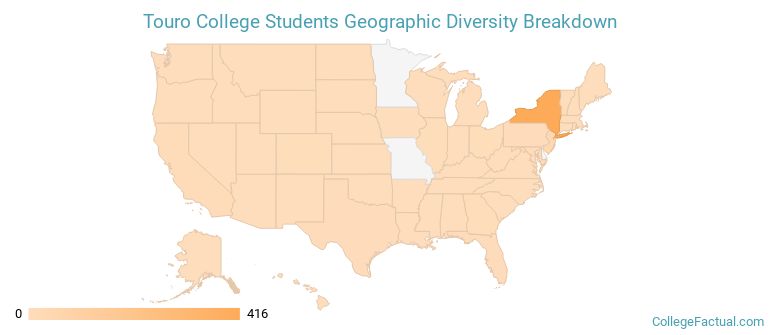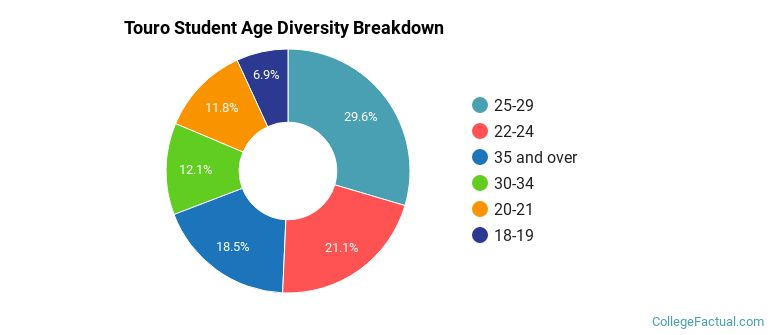 by our College Data Analytics Team
by our College Data Analytics TeamTouro total enrollment is approximately 11,699 students. 3,683 are undergraduates and 3,616 are graduate students.
Male/Female Breakdown of Undergraduates
The full-time Touro undergraduate population is made up of 67% women, and 33% men.

For the gender breakdown for all students, go here.
Touro Racial/Ethnic Breakdown of Undergraduates

| Race/Ethnicity | Number |
|---|---|
| White | 2,377 |
| Black or African American | 422 |
| Unknown | 373 |
| Hispanic | 271 |
| Asian | 99 |
| International | 99 |
| Multi-Ethnic | 29 |
| Native Hawaiian or Pacific Islander | 8 |
See racial/ethnic breakdown for all students.
Male/Female Breakdown of Graduate Students
About 62% of full-time grad students are women, and 38% men.

For the gender breakdown for all students, go here.
Touro Racial-Ethnic Breakdown of Graduate Students

| Race/Ethnicity | Number |
|---|---|
| White | 1,796 |
| Asian | 724 |
| Hispanic | 391 |
| Black or African American | 297 |
| International | 157 |
| Unknown | 130 |
| Multi-Ethnic | 119 |
| Native Hawaiian or Pacific Islander | 1 |
See racial/ethnic breakdown for all students.

| Race/Ethnicity | Number |
|---|---|
| White | 6,440 |
| Hispanic | 1,382 |
| Black or African American | 1,304 |
| Asian | 1,036 |
| Unknown | 997 |
| International | 301 |
| Multi-Ethnic | 205 |
| Native Hawaiian or Pacific Islander | 21 |

There are approximately 8,180 female students and 3,519 male students at Touro.
Touro ranks 951 out of 2,183 when it comes to geographic diversity.
20.31% of Touro students come from out of state, and 8.13% come from out of the country.

The undergraduate student body is split among 19 states (may include Washington D.C.). Click on the map for more detail.

| State | Amount |
|---|---|
| New York | 416 |
| New Jersey | 41 |
| Maryland | 10 |
| California | 9 |
| Pennsylvania | 6 |
Students from 66 countries are represented at this school, with the majority of the international students coming from Canada, India, and Belarus.
Learn more about international students at Touro.
A traditional college student is defined as being between the ages of 18-21. At Touro, 18.06% of students fall into that category, compared to the national average of 60%.

| Student Age Group | Amount |
|---|---|
| 25-29 | 3,410 |
| 22-24 | 2,436 |
| 35 and over | 2,133 |
| 30-34 | 1,401 |
| 20-21 | 1,360 |
| 18-19 | 791 |
| Under 18 | 0 |
Footnotes
*The racial-ethnic minorities count is calculated by taking the total number of students and subtracting white students, international students, and students whose race/ethnicity was unknown. This number is then divided by the total number of students at the school to obtain the racial-ethnic minorities percentage.
References
Department of Homeland Security Citizenship and Immigration Services
Image Credit: By Matthew G. Bisanz under License